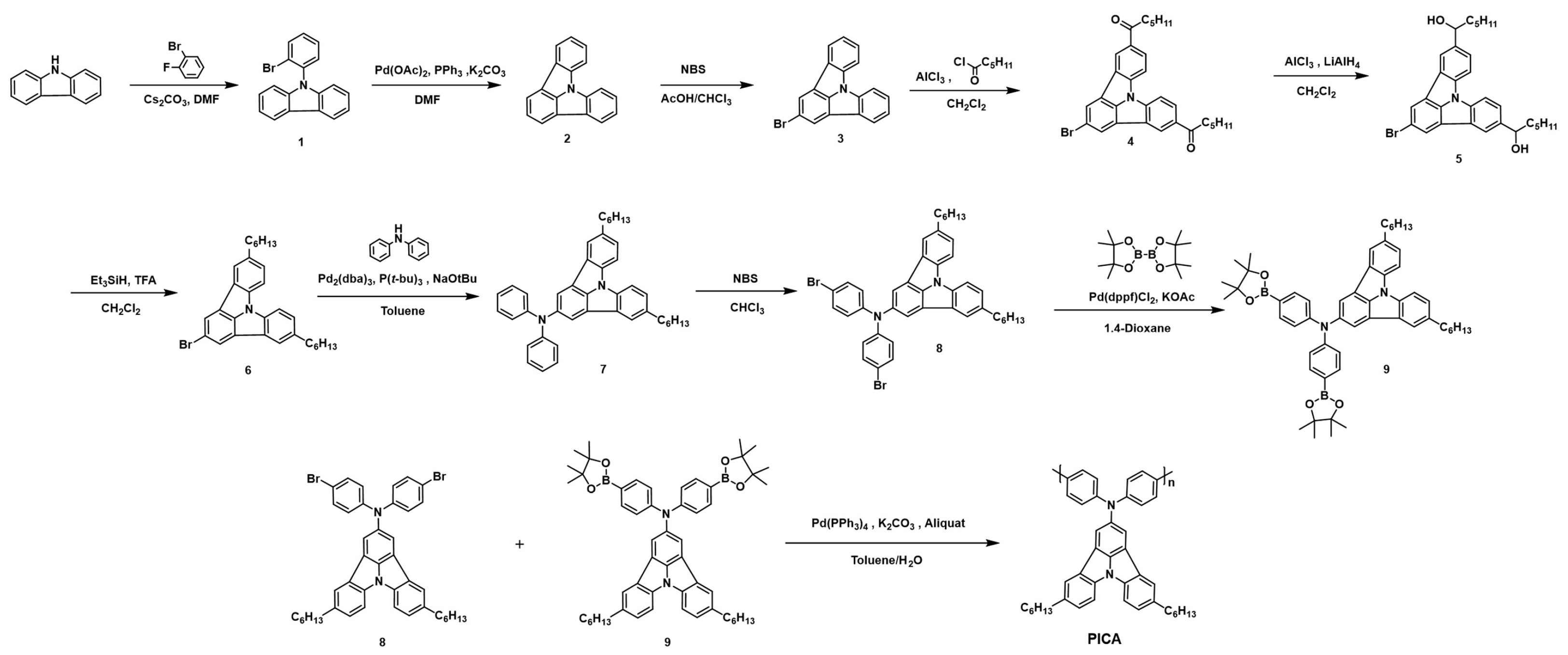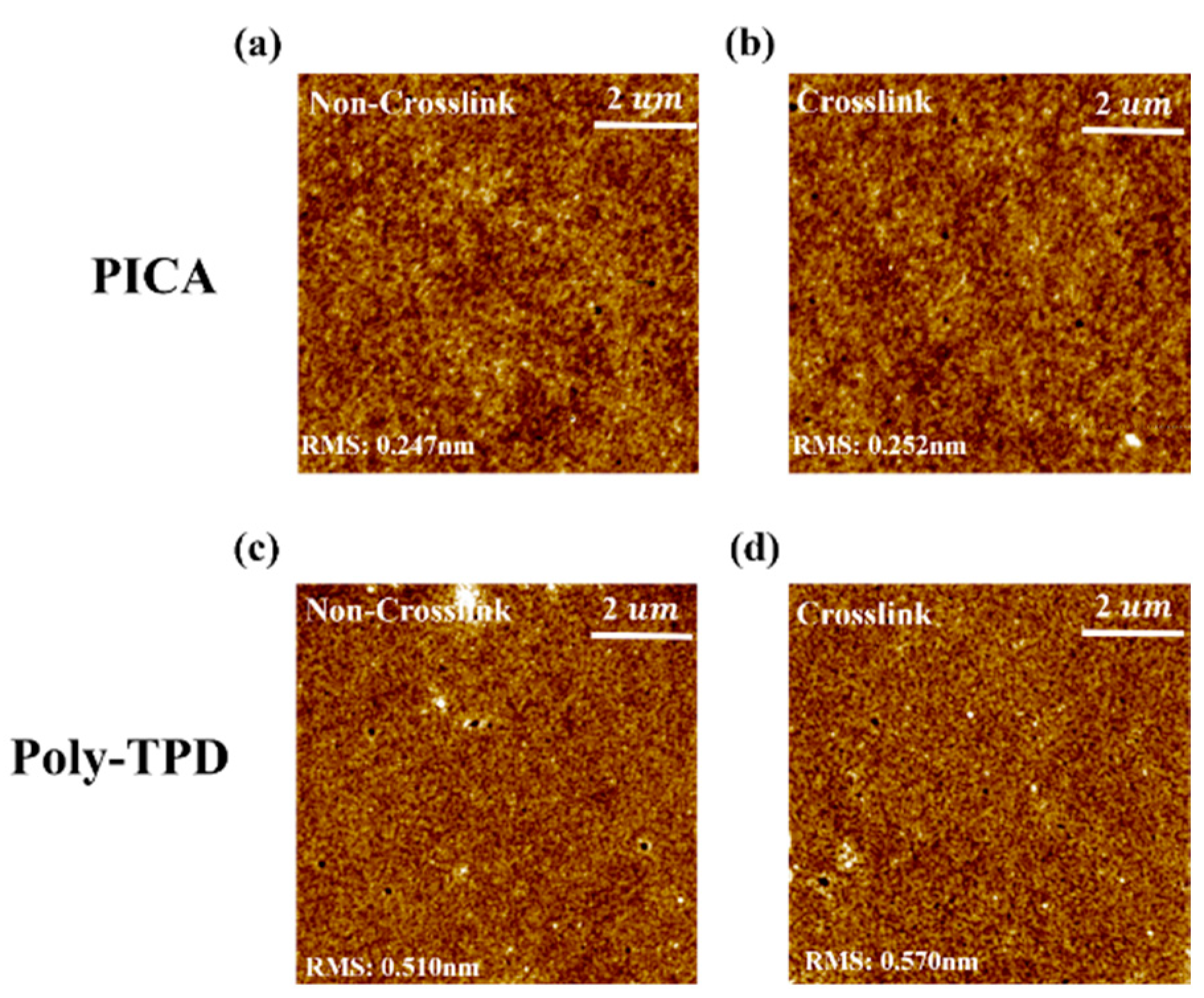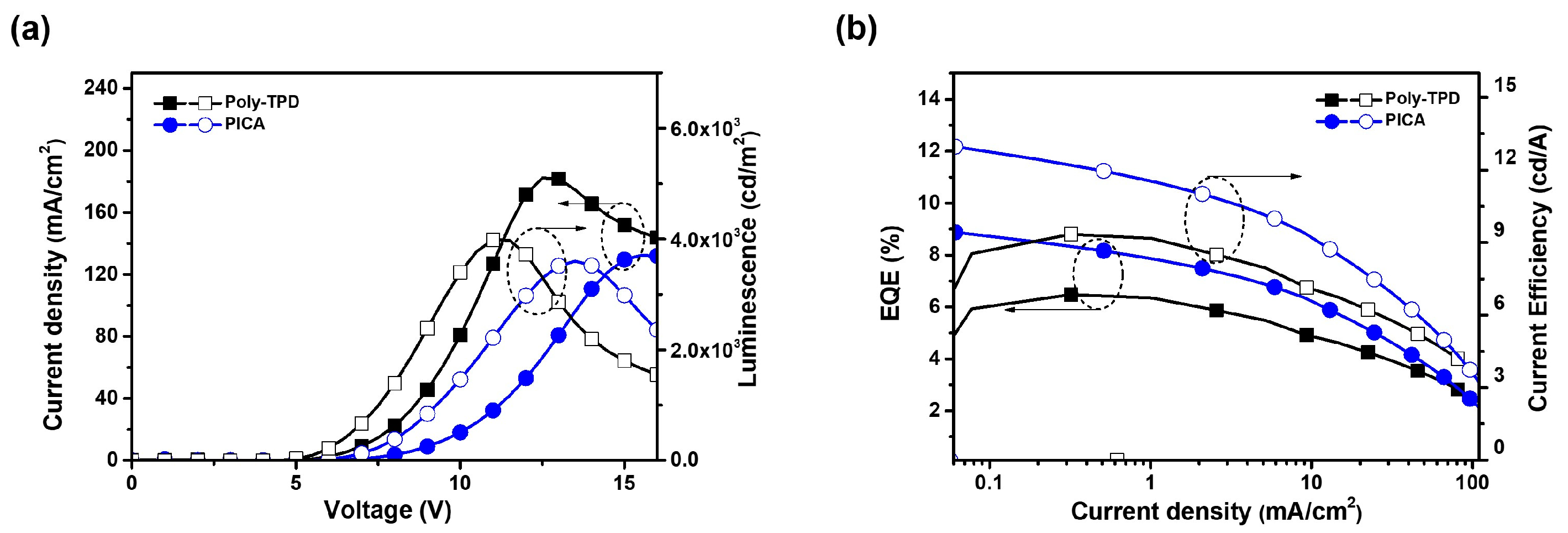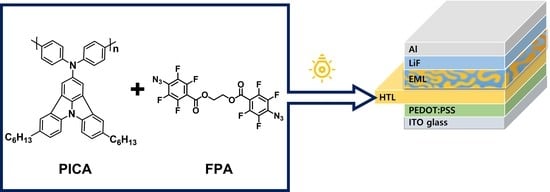Indolocarbazole-Based Photo-Crosslinkable Hole-Transporting Layer for Efficient Solution-Processed Organic Light-Emitting Diodes
Abstract
:1. Introduction
2. Materials and Methods
2.1. Materials
2.2. Synthesis
2.3. Measurements
2.4. Fabrication of OLED Devices
3. Results and Discussion
3.1. Synthesis and Characterization of PICA
3.2. Crosslinking and Solvent Resistance Tests
3.3. Hole-Only Devices Based on PICA
3.4. Surface Morphology of PICA and Poly-TPD
3.5. Performances of OLEDs Based on PICA
4. Conclusions
Supplementary Materials
Author Contributions
Funding
Data Availability Statement
Conflicts of Interest
References
- Reineke, S.; Lindner, F.; Schwartz, G.; Seidler, N.; Walzer, K.; Lussem, B.; Leo, K. White organic light-emitting diodes with fluorescent tube efficiency. Nature 2009, 459, 234–238. [Google Scholar] [CrossRef] [PubMed]
- Kim, K.J.; Kim, G.H.; Lampande, R.; Ahn, D.H.; Im, J.B.; Moon, J.S.; Lee, J.K.; Lee, J.Y.; Lee, J.Y.; Kwon, J.H. A new rigid diindolocarbazole donor moiety for high quantum efficiency thermally activated delayed fluorescence emitter. J. Mater. Chem. C 2018, 6, 1343–1348. [Google Scholar] [CrossRef]
- Wang, Y.; Wang, W.; Huang, Z.; Wang, H.; Zhao, J.; Yu, J.; Ma, D. High-efficiency red organic light-emitting diodes based on a double-emissive layer with an external quantum efficiency over 30%. J. Mater. Chem. C 2018, 6, 7042–7045. [Google Scholar] [CrossRef]
- Tang, C.W.; VanSlyke, S.A. Organic electroluminescent diodes. Appl. Phys. Lett. 1987, 51, 913–915. [Google Scholar] [CrossRef]
- Chiba, T.; Pu, Y.-J.; Miyazaki, R.; Nakayama, K.-I.; Sasabe, H.; Kido, J. Ultra-high efficiency by multiple emission from stacked organic light-emitting devices. Org. Electron. 2011, 12, 710–715. [Google Scholar] [CrossRef]
- Ahn, D.A.; Lee, S.; Chung, J.; Park, Y.; Suh, M.C. Impact of Interface Mixing on the Performance of Solution Processed Organic Light Emitting Diodes—Impedance and Ultraviolet Photoelectron Spectroscopy Study. ACS Appl. Mater. Interfaces 2017, 9, 22748–22756. [Google Scholar] [CrossRef]
- Liu, B.; Hu, S.; Zhang, L.; Xiao, P.; Huang, L.; Liu, C. Blue Molecular Emitter-Free and Doping-Free White Organic Light-Emitting Diodes With High Color Rendering. IEEE. Electron. Device Lett. 2021, 42, 387–390. [Google Scholar] [CrossRef]
- Baldo, M.A.; Thompson, M.E.; Forrest, S.R. High-efficiency fluorescent organic light-emitting devices using a phosphorescent sensitizer. Nature 2000, 403, 750–753. [Google Scholar] [CrossRef]
- Sasabe, H.; Kido, J. Multifunctional Materials in High-Performance OLEDs: Challenges for Solid-State Lighting. Chem. Mater. 2011, 23, 621–630. [Google Scholar] [CrossRef]
- Markham, J.P.J.; Lo, S.C.; Magennis, S.W.; Burn, P.L.; Samuel, I.D.W. High-efficiency green phosphorescence from spin-coated single-layer dendrimer light-emitting diodes. Appl. Phys. Lett. 2002, 80, 2645–2647. [Google Scholar] [CrossRef] [Green Version]
- Chang, S.-C.; Liu, J.; Bharathan, J.; Yang, Y.; Onohara, J.; Kido, J. Multicolor Organic Light-Emitting Diodes Processed by Hybrid Inkjet Printing Adv. Mater. 1999, 11, 734–737. [Google Scholar]
- Huang, F.; Cheng, Y.-J.; Zhang, Y.; Liu, M.S.; Jen, A.K.-Y. Crosslinkable hole-transporting materials for solution processed polymer light-emitting diodes. J. Mater. Chem. C 2008, 18, 4495–4509. [Google Scholar] [CrossRef]
- Jeong, C.H.; Godumala, M.; Yoon, J.; Choi, S.; Kim, Y.W.; Choi, D.H.; Cho, M.J.; Choi, D.H. Hole-Transporting Side-Chain Polymer Bearing a Thermally Crosslinkable Bicyclo[4.2.0]octa-1,3,5-trien-3-yl Group for High-Performing Thermally Activated Delayed Fluorescence OLED. ACS Appl. Mater. Interfaces 2019, 11, 17602–17609. [Google Scholar] [CrossRef]
- Ma, B.; Lauterwasser, F.; Deng, L.; Zonte, C.S.; Kim, B.J.; Fréchet, J.M.J. New Thermally Cross-Linkable Polymer and Its Application as a Hole-Transporting Layer for Solution Processed Multilayer Organic Light Emitting Diodes. Chem. Mater. 2007, 19, 4827–4832. [Google Scholar] [CrossRef]
- Park, J.; Lee, C.; Jung, J.; Kang, H.; Kim, K.-H.; Ma, B.; Kim, B.J. Facile Photo-Crosslinking of Azide-Containing Hole-Transporting Polymers for Highly Efficient, Solution-Processed, Multilayer Organic Light Emitting Devices. Adv. Funct. Mater. 2014, 24, 7588–7596. [Google Scholar] [CrossRef]
- Lee, T.-W.; Chung, Y.; Kwon, O.; Park, J.-J. Self-Organized Gradient Hole Injection to Improve the Performance of Polymer Electroluminescent Devices. Adv. Funct. Mater. 2007, 17, 390–396. [Google Scholar] [CrossRef]
- Ha, H.; Shim, Y.J.; Lee, D.H.; Park, E.Y.; Lee, I.-H.; Yoon, S.-K.; Suh, M.C. Highly Efficient Solution-Processed Organic Light-Emitting Diodes Containing a New Cross-linkable Hole Transport Material Blended with Commercial Hole Transport Materials. ACS Appl. Mater. Interfaces 2021, 13, 21954–21963. [Google Scholar] [CrossRef]
- Müller, C.D.; Falcou, A.; Reckefuss, N.; Rojahn, M.; Wiederhirn, V.; Rudati, P.; Frohne, H.; Nuyken, O.; Becker, H.; Meerholz, K. Multi-color organic light-emitting displays by solution processing. Nature 2003, 421, 829–833. [Google Scholar] [CrossRef]
- Jungermann, S.; Riegel, N.; Müller, D.; Meerholz, K.; Nuyken, O. Novel Photo-Cross-Linkable Hole-Transporting Polymers: Synthesis, Characterization, and Application in Organic Light Emitting Diodes. Macromolecules 2006, 39, 8911–8919. [Google Scholar] [CrossRef]
- Yan, H.; Scott, B.J.; Huang, Q.T.; Marks, J. Enhanced Polymer Light-Emitting Diode Performance Using a Crosslinked-Network Electron-Blocking Interlayer. Adv. Mater. 2004, 16, 1948–1953. [Google Scholar] [CrossRef]
- Lee, S.; Lyu, Y.Y.; Lee, S.H. The use of cross-linkable interlayers to improve device performances in blue polymer light-emitting diodes. Synth. Met. 2006, 156, 1004–1009. [Google Scholar] [CrossRef]
- Kwak, S.L.; Park, H.J.; Jang, J.-H.; Park, J.Y.; Park, J.M.; Lee, J.; Hwang, D.-H. Synthesis and characterization of thermally cross-linkable poly(iminoarylene)-based hole injection layer for solution-processed organic light-emitting diodes. Chem. Eng. J. 2023, 454, 139944. [Google Scholar] [CrossRef]
- Huang, C.W.; Chiang, F.-C.; Chu, Y.-L.; Lai, C.-C.; Lin, T.-E.; Zhu, C.-Y.; Kuo, S.-W. A solvent-resistant azide-based hole injection/transporting conjugated polymer for fluorescent and phosphorescent light-emitting diodes. J. Mater. Chem. C 2015, 3, 8142–8151. [Google Scholar] [CrossRef]
- Png, R.-Q.; Chia, P.J.; Tang, J.-C.; Liu, B.; Sivaramakrishnan, S.; Zhou, M.; Khong, S.-H.; Chan, H.S.O.; Burroughes, J.H.; Chua, L.L.; et al. High-performance polymer semiconducting heterostructure devices by nitrene-mediated photocrosslinking of alkyl side chains. Nat. Mater. 2010, 9, 152–158. [Google Scholar] [CrossRef] [PubMed]
- Yang, J.; Hahm, D.; Kim, K.; Rhee, S.; Lee, M.; Kim, S.; Chang, J.H.; Park, H.W.; Lim, J.; Lee, M.; et al. High-resolution patterning of colloidal quantum dots via non-destructive, light-driven ligand crosslinking. Nat. Commun. 2020, 11, 2874. [Google Scholar] [CrossRef] [PubMed]
- Park, J.Y.; Jang, J.-H.; Lee, J.-H.; Hwang, D.-H. Solution-processed organic light-emitting diodes using a photo-crosslinkable hole-trnasporting layer. J. Nanosci. Nanotechnol. 2020, 20, 4661–4665. [Google Scholar] [CrossRef] [PubMed]
- Wharton, S.-I.; Henry, J.B.; McNab, H.; Mount, A.R. The Production and Characterisation of Novel Conducting Redox-Active Oligomeric Thin Films From Electrooxidized Indolo[3,2,1-jk]carbazole. Chem. Eur. J. 2009, 15, 5482–5490. [Google Scholar] [CrossRef] [PubMed]
- Wakim, S.; Bouchard, J.; Simard, M.; Drolet, N.; Tao, Y.; Leclerc, M. Organic Microelectronics: Design, Synthesis, and Characterization of 6,12-Dimethylindolo[3,2-b]Carbazoles Chem. Mater. 2004, 16, 4386–4388. [Google Scholar]
- Li, Y.; Wu, Y.; Gardener, S.; Ong, B.S. Novel Peripherally Substituted Indolo[3,2-b]carbazoles for High-Mobility Organic Thin-Film Transistors. Adv. Mater. 2005, 17, 849–853. [Google Scholar] [CrossRef]
- Wu, Y.; Li, Y.; Gar-Dener, S.; Ong, B.S. Indolo[3,2-b]carbazole-Based Thin-Film Transistors with High Mobility and Stability. J. Am. Chem. Soc. 2005, 127, 614–618. [Google Scholar] [CrossRef]
- Ma, X.-J.; Zhu, X.-D.; Wang, K.-L.; Igbari, F.; Yuan, Y.; Zhang, Y.; Gao, C.-H.; Jiang, Z.-Q.; Wang, Z.-K.; Liao, L.-S. Planar starburst hole-transporting materials for highly efficient perovskite solar cells. Nano Energy 2019, 63, 103865. [Google Scholar] [CrossRef]
- Cao, W.; Fang, M.; Chai, Z.; Xu, H.; Duan, T.; Li, Z.; Chen, X.; Qina, J.; Han, H. New D–p–A organic dyes containing a tert-butylcapped indolo[3,2,1-jk]carbazole donor with bithiophene unit as p-linker for dye-sensitized solar cells. RSC Adv. 2015, 5, 32967–32975. [Google Scholar] [CrossRef]
- Luo, C.; Bi, W.; Deng, S.; Zhang, J.; Chen, S.; Li, B.; Liu, Q.; Peng, H.; Chu, J. Indolo[3,2,1-jk]carbazole Derivatives-Sensitized Solar Cells: Effect of π-Bridges on the Performance of Cells. J. Phys. Chem. C 2014, 118, 14211–14217. [Google Scholar] [CrossRef]
- Henry, J.B.; Wharton, S.I.; Wood, E.R.; McNab, H.; Mount, A.R. Specific Indolo[3,2,1-jk]carbazole Conducting Thin-Film Materials Production by Selective Substitution. J. Phys. Chem. A 2011, 115, 5435–5442. [Google Scholar] [CrossRef] [PubMed]
- Kim, D.H.; Cho, N.S.; Oh, H.-Y.; Yang, J.H.; Jeon, W.S.; Park, J.S.; Suh, M.C.; Kwon, J.H. Highly Efficient Red Phosphorescent Dopants in Organic Light-Emitting Devices. Adv. Mater. 2011, 23, 2721–2726. [Google Scholar] [CrossRef]
- Usluer, O.; Demic, S.; Egbe, D.A.M.; Birckner, E.; Tozlu, C.; Pivrikas, A.; Ramil, A.M.; Sariciftci, N.S. Fluorene-Carbazole Dendrimers: Synthesis, Thermal, Photophysical and Electroluminescent Device Properties. Adv. Funct. Mater. 2010, 20, 4152–4161. [Google Scholar] [CrossRef]
- Wu, C.-S.; Fang, S.-W.; Chen, Y. Solution-processable hole-transporting material containing fluorenyl core and triple-carbazolyl terminals: Synthesis and application to enhancement of electroluminescence. Phys. Chem. Chem. Phys. 2013, 15, 15121–15127. [Google Scholar] [CrossRef]
- Sundhoro, M.; Park, J.; Wu, B.; Yan, M. Synthesis of Polyphosphazenes by a Fast Perfluoroaryl Azide-Mediated Staudinger Reaction. Macromolecules 2018, 51, 4532–4540. [Google Scholar] [CrossRef]
- Konno, H.; Sasaki, Y. Selective One-pot Synthesis of Facial Tris-ortho-metalated Iridium(III) Complexes Using Microwave Irradiation. Chem. Lett. 2003, 32, 252–253. [Google Scholar] [CrossRef]
- Wang, P.-I.; Tsai, C.-Y.; Hsiao, Y.-J.; Jiang, J.-C.; Liaw, D.-J. High-Purity Semiconducting Single-Walled Carbon Nanotubes via Selective Dispersion in Solution Using Fully Conjugated Polytriarylamines. Macromolecules 2016, 49, 8520–8529. [Google Scholar] [CrossRef]









| Material | Abs. λmax (nm) | Abs. λedge (nm) | PL λmax (nm) | Eg opt (eV) | HOMO (eV) | LUMO (eV) |
|---|---|---|---|---|---|---|
| PICA | 270, 293 | 444 | 483 | 2.79 | −5.25 | −2.46 |
| HTL | Device | Vturn-on a (V) | EQEmax (%) | CIE b (x,y) | Lmax (cd/m2) | LEmax (cd/A) | PEmax (lm/W) | Hole Mobility (cm2/V·s) |
|---|---|---|---|---|---|---|---|---|
| Poly-TPD | Red | 4.5 | 6.47 | (0.64,0.35) | 4000 | 9.35 | 5.96 | 1.3 × 10−5 |
| Green | 4.0 | 8.40 | (0.30,0.64) | 8700 | 30.19 | 21.07 | ||
| PICA | Red | 5.0 | 8.88 | (0.64, 0.36) | 3600 | 12.97 | 8.12 | 2.9 × 10−5 |
| Green | 4.0 | 10.84 | (0.29, 0.64) | 10,900 | 38.47 | 25.06 |
Disclaimer/Publisher’s Note: The statements, opinions and data contained in all publications are solely those of the individual author(s) and contributor(s) and not of MDPI and/or the editor(s). MDPI and/or the editor(s) disclaim responsibility for any injury to people or property resulting from any ideas, methods, instructions or products referred to in the content. |
© 2023 by the authors. Licensee MDPI, Basel, Switzerland. This article is an open access article distributed under the terms and conditions of the Creative Commons Attribution (CC BY) license (https://creativecommons.org/licenses/by/4.0/).
Share and Cite
Park, J.Y.; Kwak, S.L.; Park, H.J.; Hwang, D.-H. Indolocarbazole-Based Photo-Crosslinkable Hole-Transporting Layer for Efficient Solution-Processed Organic Light-Emitting Diodes. Nanomaterials 2023, 13, 1934. https://doi.org/10.3390/nano13131934
Park JY, Kwak SL, Park HJ, Hwang D-H. Indolocarbazole-Based Photo-Crosslinkable Hole-Transporting Layer for Efficient Solution-Processed Organic Light-Emitting Diodes. Nanomaterials. 2023; 13(13):1934. https://doi.org/10.3390/nano13131934
Chicago/Turabian StylePark, Jeong Yong, Seon Lee Kwak, Hea Jung Park, and Do-Hoon Hwang. 2023. "Indolocarbazole-Based Photo-Crosslinkable Hole-Transporting Layer for Efficient Solution-Processed Organic Light-Emitting Diodes" Nanomaterials 13, no. 13: 1934. https://doi.org/10.3390/nano13131934
APA StylePark, J. Y., Kwak, S. L., Park, H. J., & Hwang, D.-H. (2023). Indolocarbazole-Based Photo-Crosslinkable Hole-Transporting Layer for Efficient Solution-Processed Organic Light-Emitting Diodes. Nanomaterials, 13(13), 1934. https://doi.org/10.3390/nano13131934








